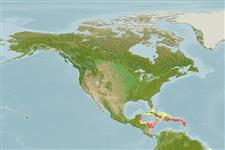>
Blenniiformes (Blennies) >
Chaenopsidae (Pike-, tube- and flagblennies)
Etymology: Emblemariopsis: Latin, emblema = insertion, inlaid work, raised ornament + Greek, opsis = appearance (Ref. 45335).
Environment: milieu / climate zone / depth range / distribution range
Écologie
marin récifal; profondeur 1 - 8 m (Ref. 125603). Tropical
Distribution
Pays | Zones FAO | Écosystèmes | Occurrences | Point map | Introductions | Faunafri
Western Central Atlantic: Belize, Honduras, south to Panama; on the islands of the western Caribbean, including San Andres and Cayman Islands; across to the northern Antilles: Mona Island, Puerto Rico, and St. Croix, St. Barthélemy, and Isla Aves, but stopping before Dominica. Apparently absent from the southern Caribbean east of Panama, i.e. Colombia, Aruba, Bonaire, Curaçao, Venezuela, Trinidad, and the Windward (southern) Lesser Antilles (Dominica, Martinique, St. Lucia, Barbados, St. Vincent and Grenadines, Grenada, and Tobago); to the north, absent from the Gulf of Mexico, Florida, the Bahamas.
Taille / Poids / Âge
Maturity: Lm ? range ? - ? cm
Max length : 2.0 cm SL mâle / non sexé; (Ref. 51458)
Description synthétique
Morphologie | Morphométrie
Épines dorsales (Total): 19 - 21; Rayons mous dorsaux (Total): 10-13; Épines anales 2; Rayons mous anaux: 19 - 21. This species with an orbital cirrus and no red banner is distinguished by the following characters: TP territorial males found in holes with a black head; the anterior dorsal fin black, with a short, thin, white margin reaching back to second membrane; the first two membranes well incised; first dorsal-fin spine relatively short, when adpressed reaching to about 5th-6th spine base, about 1/2 HL, the third and fourth spines are also shorter, subsequent spines rising to midfin spines (Ref. 125603).
Dark-shaded and transitional TP with a relatively short first dorsal-fin spine, the second spine usually equal, with third spine about 2/3 of first, the fourth spine less than 1/2 first spine, and tenth spine about equal to first, profile of anterior dorsal fin with a moderate concavity, decreasing during transition; the first three dorsal-fin membranes white tipped, tips rounded and membranes incised; usually distinct large head spots; a prominent characteristic black spot a third way along the lower lip; without dense speckling of dorsal-fin and pectoral-fin membranes; row of dark spots along lateral midline adsent, no rows of dark spots along proximal spinous-dorsal-fin membranes, and no opercular bands or lines (Ref. 125603).
IP with elongated first two dorsal-fin spines, the first spine when adpressed reaching to base of 5th-8th spine base, the second spine about equal, the third about 2/3 of first, first two membranes with white rounded tips. Colouration: live colors greenish blue and gold; the cranial pattern of bluish spots and reticulations with a greenish gold background; IP head spots are usually reduced; melanophores near pectoral-fin base with a short oblique band to none (Ref. 125603)
Life cycle and mating behavior
Maturité | Reproduction | Frai | Œufs | Fécondité | Larves
Victor, B.C., 2020. Review of the glass blennies (Teleostei: Chaenopsidae: Emblemariopsis) with two new species from the Caribbean Sea. J. Ocean Sci. Foundation 37:1-122. (Ref. 125603)
Statut dans la liste rouge de l'IUCN (Ref. 130435)
Menace pour l'homme
Harmless
Utilisations par l'homme
Plus d'informations
PaysZones FAOÉcosystèmesOccurrencesIntroductionsStocksÉcologieRégime alimentaireÉléments du régime alimentaireConsommation alimentaireRation
Noms communsSynonymesMétabolismePrédateursÉcotoxicologieReproductionMaturitéFraiRassemblement de ponteFéconditéŒufsDéveloppement de l'œuf
Taille/ÂgeCroissanceLongueur-poidsLongueur-longueurFréquences de longueursMorphométrieMorphologieLarvesDynamique des populations larvairesRecrutementAbondanceBRUVS
RéférencesAquacultureProfil d'aquacultureSouchesGénétiqueElectrophoresesHéritabilitéPathologiesTraitementNutrientsMass conversion
CollaborateursImagesStamps, Coins Misc.SonsCiguateraVitesseType de nageSurface branchialeOtolithesCerveauxVision
Outils
Articles particuliers
Télécharger en XML
Sources Internet
Estimates based on models
Preferred temperature (Ref.
123201): 27.3 - 28.2, mean 27.8 °C (based on 156 cells).
Phylogenetic diversity index (Ref.
82804): PD
50 = 0.5001 [Uniqueness, from 0.5 = low to 2.0 = high].
Bayesian length-weight: a=0.00457 (0.00183 - 0.01143), b=3.08 (2.86 - 3.30), in cm total length, based on LWR estimates for this (Sub)family-body shape (Ref.
93245).
Niveau trophique (Ref.
69278): 3.1 ±0.4 se; based on size and trophs of closest relatives
Fishing Vulnerability (Ref.
59153): Low vulnerability (10 of 100).
